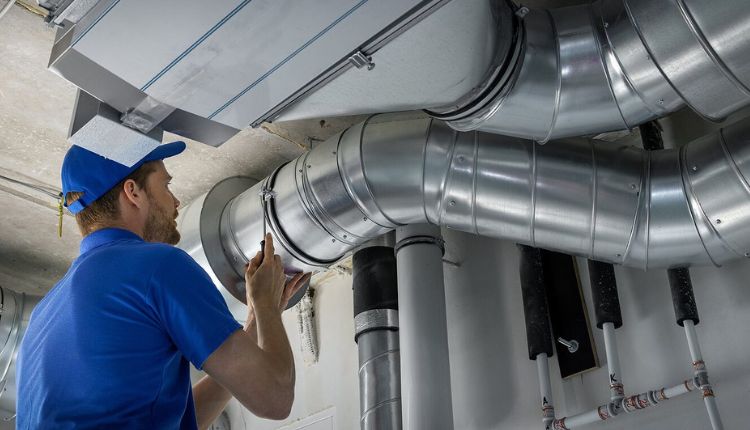Ever Wonder Why Some Rooms Feel Too Hot or Too Cold?
Have you ever walked from one room to another in your house and felt a big change in temperature? Maybe your bedroom is always too hot while the living room feels like an icebox. The problem might be hiding in your walls and ceilings – your HVAC duct size.
Most homeowners don’t think much about their air ducts. But the size of these hidden pathways has a huge impact on how comfortable your home feels and how much you pay in energy bills each month.
What Are HVAC Ducts Anyway?
Think of your HVAC ducts as the highways that carry air throughout your home. They’re the tubes that connect your heating and cooling system to each room.
HVAC duct size simply means how big around these air highways are. When they’re the wrong size, they can cause all sorts of problems for your comfort and your wallet.
The Straw Analogy: Why Size Matters
Imagine drinking a thick milkshake through a tiny coffee stirrer versus a regular straw. Pretty hard, right? That’s exactly what happens when your HVAC duct size is too small.
Your system has to work extra hard to push air through spaces that are too tight. This wastes energy and puts a lot of strain on your equipment.
Too Small vs. Too Big: Both Cause Problems
When Ducts Are Too Small
When ducts are too small, your system struggles like you would trying to blow up a balloon through a skinny straw. This creates several issues:
- Your system runs longer, but rooms never get comfortable
- Some rooms get too little air while others get too much
- You hear whistling or rushing sounds from your vents
When Ducts Are Too Large
Believe it or not, ducts that are too big cause problems, too:
- Air moves too slowly and doesn’t reach far rooms
- Your system cycles on and off too quickly
- Humidity control gets thrown off balance
Warning Signs in Your Home
How can you tell if your HVAC duct size is wrong? Look for these clues:
Temperature Differences
Walk through your house. Do some rooms feel like different climate zones? That’s a big red flag.
Higher Energy Bills
Have your bills been creeping up even though your habits haven’t changed? Your ducts might be making your system work overtime.
Constant Running
Does your system seem to run forever without making your home comfortable? Poorly sized ducts often cause this frustrating problem.
The Money Factor: How Duct Size Affects Your Budget
Monthly Energy Costs
The wrong HVAC duct size can increase your energy bills by 20-30%. For many homes, that’s hundreds of dollars wasted every year!
System Replacement Costs
There’s an even bigger cost hiding down the road. Systems with wrong-sized ducts often break down years earlier than they should. When a new system costs thousands of dollars, that’s a repair bill no one wants.
Breathing Easier: The Health Connection
Did you know that HVAC duct size affects your family’s health, too? Here’s how:
Dust and Allergens
When ducts are the wrong size, dust and allergens can build up in certain spots. Later, these particles get blown into your home, causing sneezing, coughing, and irritated eyes.
Air Quality
Properly sized ducts allow your filters to work better. This means cleaner air for everyone in your home, which is especially important for anyone with asthma or allergies.
Getting It Right: How Pros Size Ducts
Figuring out the right HVAC duct size isn’t simple. Professionals use special calculations that look at:
- The size of each room
- How much sun the room gets
- How well your walls are insulated
- The power of your heating and cooling equipment
This process is called a Manual D calculation. It’s much more accurate than guessing or using rules of thumb.
The DIY Danger Zone
Some homeowners try to save money by sizing their own ducts. This almost always backfires. Common mistakes include:
- Using the same size duct everywhere
- Not accounting for turns and bends that restrict airflow
- Forgetting about return air needs
These errors can make your system perform worse than before!
Can You Fix Bad Ducts in an Existing Home?
If you’re not building a new house, you might wonder if it’s possible to fix duct problems you already have. The good news is that improvements are often possible:
Partial Fixes
Sometimes, changing just the worst sections of ductwork can make a big difference. Adding properly sized return ducts or fixing crushed sections can improve performance without replacing everything.
Complete Redesign
In some cases, a complete redo of your duct system makes the most sense. While this costs more upfront, the comfort and savings often make it worthwhile in the long run.
The Comfort Revolution: Life with Right-Sized Ducts
What changes can you expect after fixing your HVAC duct size problems?
Temperature Consistency
No more hot and cold spots! Every room stays at the temperature you set.
Lower Bills
Many homeowners see their energy bills drop by 20% or more after fixing duct sizing issues.
Quieter Operation
Properly sized ducts run more quietly. No more rushing air sounds keeping you up at night.
Longer System Life
Your expensive HVAC equipment lasts years longer when it doesn’t have to struggle against bad ductwork.
Taking Action: What to Do Next
If you suspect your HVAC duct size might be wrong, start by paying attention to how your home feels. Make note of rooms that never seem comfortable or strange noises coming from your vents.
A proper duct evaluation can tell you for sure if your ducts are sized correctly. This inspection can identify specific problems and suggest the most cost-effective solutions.
Conclusion: The Hidden Key to Home Comfort
HVAC duct size might not be something you think about every day, but it has a huge impact on your daily comfort and long-term budget. By understanding this often-overlooked part of your home, you’re better equipped to make smart decisions about your heating and cooling system.
Remember that getting duct sizing right requires professional HVAC skills and tools. But knowing what questions to ask puts you ahead of most homeowners. Your family’s comfort – and your energy bills – will thank you for paying attention to this important detail.






